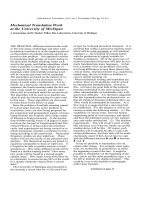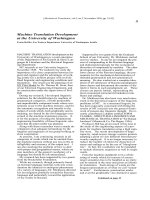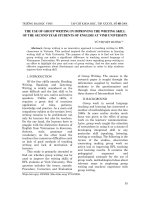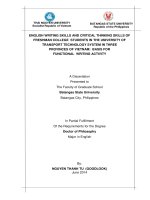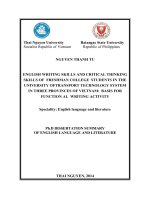THE UNIVERSITY OF DANANG
Bạn đang xem bản rút gọn của tài liệu. Xem và tải ngay bản đầy đủ của tài liệu tại đây (1.18 MB, 108 trang )
THE UNIVERSITY OF DANANG
UNIVERSITY OF FOREIGN LANGUAGE STUDIES
----------------------------------
NGUYỄN THỊ BÍCH PHỤNG
STRATEGIES IN THE ENGLISH TRANSLATION OF
NOMINALISATIONS DENOTING MINDFULNESS IN
"ĐƯỜNG XƯA MÂY TRẮNG" AND “PHÉP LẠ CỦA SỰ TỈNH
THỨC” BY THICH NHAT HANH
MASTER THESIS
IN THE ENGLISH LANGUAGE
Da Nang, 2017
I
THE UNIVERSITY OF DANANG
UNIVERSITY OF FOREIGN LANGUAGE STUDIES
------------------------------------
NGUYỄN THỊ BÍCH PHỤNG
STRATEGIES IN THE ENGLISH TRANSLATION OF
NOMINALISATIONS DENOTING MINDFULNESS IN
"ĐƯỜNG XƯA MÂY TRẮNG" AND “PHÉP LẠ CỦA SỰ TỈNH
THỨC” BY THICH NHAT HANH
Major
: The English Language
Code
:
MASTER THESIS IN THE ENGLISH LANGUAGE
SUPERVISOR: LÊ THỊ GIAO CHI, Ph.D.
Da Nang, 2017
II
STATEMENT OF AUTHORSHIP
Except where reference is made in the text of the thesis, this thesis
contains no material published elsewhere or extracted in whole or in part from
a thesis by which I have qualified for or been awarded another degree or
diploma.
No other person‘s work has been used without due acknowledgements in
the thesis.
This thesis has not been submitted for the award of any degree or
diploma in any other tertiary institution.
Da Nang, October 2017
Nguyen Thi Bich Phung
III
ABSTRACT
This is a study on the strategies used in rendering Vietnamese
nominalisations denoting mindfulness into English. In this paper, 650 samples
of Vietnamese nominalisations in the book ―Đường Xưa Mây Trắng” and 250
samples of Vietnamese nominalisations in ―Phép Lạ Của Sự Tỉnh Thức‖ by Thich
Nhat Hanh denoting mindfulness and their English translational equivalents were
extracted and analysed, which based on Vinay and Darbelnet‘s (1995/2000)
methodology of translation and the other strategies such as explicitation and
simplification according to translation theory of Baker (1996) and Blum-Kulla
(1986/2000).
This research is also intended to draw out some implications in
teaching, learning and translating. Besides, some suggestions are made for
further study in this area.
IV
ACKNOWLEDGEMENTS
After conducting a research on the topic ―strategies in English Translation
of Nominalisations Denoting Mindfulness in Đường Xưa Mây Trắng‖ and
―Phép Lạ Của Sự Tỉnh Thức‖, I would like to give many words of thanks to many
peoples that supported and helped me.
First at all, I want to express my deepest gratitude to my supervisor, Mrs. Le
Thi Giao Chi, Ph.D who has given me her devoted guidances and
valuable
comments as well as provided me with useful sources of materials and spent her
priceless time for my paper.
Next, I would like to thanks my master and my loving family for
encouraging and supporting me with the best advices.
Finally, I wish to give my sincere thanks to my close friends who always
assisted me in the process of completing this research.
V
TABLE OF CONTENTS
ABSTRACT ...................................................................................................IV
ACKNOWLEDGEMENTS........................................................................... V
TABLE OF CONTENTS..............................................................................VI
LIST OF TABLES ........................................................................................XI
LIST OF ABBREVIATIONS .................................................................... XII
Chapter One INTRODUTION ................................................................. - 1 1.1 Rationale ............................................................................................... - 1 1.2 Aims and Objectives ............................................................................ - 2 1.2.1 Aims .............................................................................................. - 2 1.2.2 Objectives ..................................................................................... - 3 1.3 Scope of study ....................................................................................... - 3 1.4 Research questions ............................................................................... - 4 1.5 Definition of terms................................................................................ - 4 1.6 Organisation of the Study................................................................... - 5 Chapter Two
LITERATURE REVIEW AND THEORETICAL BACKGROUND .. - 6 2.1 Literature Review................................................................................. - 6 2.2 Theoretical Background ...................................................................... - 8 2.2.1
Definition of Translation ......................................................... - 8 -
2.2.2
Translation Equivalence ........................................................ - 10 -
2.2.3
Translation Universals ........................................................... - 12 -
2.2.3.1 The Notion of Translation Universals .......................... - 12 2.2.3.2 Common Translation Universals................................... - 13 2.2.3.2.1 Explicitation ............................................................. - 13 2.2.3.2.2 Simplification ........................................................... - 16 -
VI
2.2.4
Vinay and Darbelnet’s Methodology of Translation .......... - 17 -
2.2.5
Nominalisation in English and Vietnamese ......................... - 19 -
2.2.5.1 The Notion of Nominalisation ........................................ - 19 2.2.5.2 Nominalisation in English ................................................ - 21 2.2.5.2.1 Nominalisations Derived by Affixation ................. - 21 2.2.5.2.2 Nominalisations Derived by Conversion or Zerosufixation .................................................................................. - 22 2.2.5.3 Nominalisations in Vietnamese ...................................... - 23 2.2.5.3.1 Nominalisations Derived by Nominal Classifiers .. - 23 2.2.5.3.2 Nominalisations Derived by Conversion or Zerosufixation .................................................................................. - 24 Chapter Three
RESEARCH METHODOLOGY ........................................................... - 26 3.1 Research Design and Methodology .................................................. - 26 3.1.1 Research Design ......................................................................... - 26 3.1.2 Methodology............................................................................... - 26 3.2.
Research Procedures.................................................................... - 27 -
3.2.1
Data collection and corpus building ..................................... - 27 -
3.2.2. Data Analysis .......................................................................... - 28 3.2.3. Research Procedures.............................................................. - 29 Chapter Four
DISCUSSION OF FINDINGS ................................................................ - 30 4.1 An overview of nominalisations formulation in Vietnamese ......... - 30 4.1.1. De-verbal nominalisations with sự, việc, cái, nỗi, cuộc, con
đường, nếp sống, đạo, đạo lý, tình, công phu, trạng thái, cánh cửa, chìa
khóa, hạt giống. ................................................................................... - 31 -
VII
4.1.1.1. De-verbal Nominalisation with Sự ................................. - 31 4.1.1.2. De-verbal nominalisation with Việc ............................... - 32 4.1.1.3. De-verbal nominalisation with Cuộc.............................. - 32 4.1.1.4. De-verbal nominalisation with Cái................................. - 33 4.1.1.6. De-verbal nominalisation by conversion ....................... - 35 4.1.2. De-adjectival nominalisations with Sự, Niềm, Lòng, Cái...... - 36 4.1.2.1. De-adjectival nominalisation with Sự ............................ - 36 4.1.2.2. De-adjectival nominalisation with Niềm ........................ - 37 4.1.2.3. De-adjectival nominalisation with Lòng ........................ - 37 4.1.2.4. De-adjectival nominalisation with Cái ........................... - 37 4.1.2.5. De-adjectival nominalisation by conversion ................. - 38 4.2. Strategies in English Translation of Nominalisations Denoting
Mindfulness in “Đường Xưa Mây Trắng” and “Phép Lạ Của Sự Tỉnh
Thức” ......................................................................................................... - 39 4.2.1. Literal Translation in Translating Nominalisations denoting
mindfulness in “Đường Xưa Mây Trắng” and “Phép Lạ Của Sự Tỉnh
Thức” ................................................................................................... - 39 4.2.1.1.
Literal
Translation
in
translating
de-verbal
nominalisations denoting mindfulness ........................................ - 39 4.2.1.2.
Literal
Translation
in
translating
de-adjectival
nominalisations denoting mindfulness ........................................ - 45 4.2.1.3. Literal Translation in translating Nominalisations derived
by conversion denoting mindfulness ........................................... - 46 4.2.2.
Transposition
in
Translating
Nominalisations
denoting
mindfulness in “Đường Xưa Mây Trắng” and “Phép Lạ Của Sự Tỉnh
Thức” ................................................................................................... - 50 -
VIII
4.2.2.1. Transposition in translating de-verbal nominalisations
denoting mindfulness .................................................................... - 53 4.2.2.2. Transposition in translating de-adjectival nominalisations
denoting mindfulness .................................................................... - 55 4.2.2.3. Transposition in translating Nominalisations derived by
conversion denoting mindfulness ................................................ - 56 4.2.3.
Explicitation
in
translating
nominalisations
denoting
mindfulness in “Đường Xưa Mây Trắng” and “Phép Lạ Của Sự Tỉnh
Thức” ................................................................................................... - 59 4.2.3.1. Lexical Explicitation in translating de-verbalised, deadjectivized and converted nouns ............................................... - 60 4.2.3.2. Syntactic Explicitation in translating de-verbalised, deadjectivized and converted nouns ............................................... - 64 4.2.3.3. Stylistic Explicitation in translating de-verbalised, deadjectivized and converted nouns ............................................... - 65 4.2.4.
Simplification
in
Translating
Nominalisations
denoting
mindfulness in “Đường Xưa Mây Trắng” and “Phép Lạ Của Sự Tỉnh
Thức” ................................................................................................... - 69 4.2.4.1. Lexical Simplification in translating de-verbalised, deadjectivized and converted nouns ............................................... - 70 4.2.4.2. Syntactic Simplification in translating de-verbalised, deadjectivized and converted nouns ............................................... - 74 4.2.4.3. Stylistic Simplification in translating de-verbalised, deadjectivized and converted nouns ............................................... - 75 4.2.5. Summary ................................................................................... - 78 4.3. Summary of the chapter ................................................................... - 80 -
IX
Chapter Five ............................................................................................. - 82 CONCLUSION ......................................................................................... - 82 5.1 Conclusion ........................................................................................... - 82 5.2 Some Implications for Teaching, Learning and Translating
Vietnamese Nominalisations in "Đường Xưa Mây Trắng” and “Phép Lạ
Của Sự Tỉnh Thức” into English ............................................................. - 85 5.2.1 Implication on the Language Teaching and Learning .......... - 85 5.2.2 Implication on Translation Work ............................................ - 86 5.3 Limitation of the study ...................................................................... - 87 5.4 Suggestions for the study ................................................................... - 87 REFERENCES ......................................................................................... - 89 -
X
LIST OF TABLES
Table 4.1 Distribution of occurrences of literal translation in translating
kinds of nominalisations in both texts ....................................... - 49 Table 4.2
Types of Transposition of Word Class in Translating
Nominalisations Denoting Mindfulness ..................................... - 50 Table 4.3 Distribution of occurrences of transposition in translating kinds of
nominalisations in both texts ..................................................... - 58 Table 4.4 Distribution of occurrences of explicitation types in translating
nominalisations in both texts ..................................................... - 68 Table 4.5 Distribution of occurrences of simplification types in translating
nominalisations in both texts ..................................................... - 77 Table 4.6 Summary of Frequencies of strategies used in ―Đường Xưa Mây
Trắng‖ and ―Phép Lạ Của Sự Tỉnh Thức‖ .............................. - 78 Table 4.7 Distribution of occurrences and percentages of strategies found in
rendering nominalisations in both ―Đường Xưa Mây Trắng‖ and
―Phép Lạ Của Sự Tỉnh Thức‖ texts ......................................... - 79 -
XI
LIST OF ABBREVIATIONS
DXMT
Đường Xưa Mây Trắng
PLCSTT
Phép Lạ Của Sự Tỉnh Thức
SL
Source language
TL
Target language
ST
Source text
TT
Target text
N
Noun
NP
Noun Phrase
VP
Verb Phrase
Adj
Adjective
Adv
Adverb
NMLZ
Nominaliser
XII
Chapter One INTRODUTION
1.1 Rationale
As a Vietnamese Buddhist monk, Thich Nhat Hanh has made a great
contribution to the career of Buddhist development in the country as well as in the
world. He has been known as a zen master who offered practical exercises or
methods of mindfulness, which have the ability to bring human beings to come back
an awakened and joyful state in the present life. In the process of his studying and
practising based on the foundation of the basic doctrines of Shakyamuni Buddha
more than 2500 years ago, he also published many books relating to the Buddhist
issues in Vietnamese; and many of them have been translated into many other
languages. Among these are such English translational versions as An Lạc Từng
Bước Chân, Trái Tim Mặt Trời, Phép Lạ Của Sự Tỉnh Thức, Trái Tim Của Bụt,
Tỉnh Lặng, Đường Xưa Mây Trắng, Trái Tim Của Hiểu Biết, Sen Búp Từng Cánh
Hé, Thương Yêu Theo Phương Pháp Bụt Dạy, Nuôi Dưỡng Tâm Bồ Đề , to name
just a few, which have so far attracted great interest from readers and Buddhism
followers from many countries.
More interestingly, with his famous works, people have discovered his
condensed and sophisticated style of writing in hiding the bold marks of Buddhism.
Thanks to the fact that the language of writing is condensed but deeply- expressed,
he enhanced in his Buddhism books the value of messages from the inner implicit
layers of meanings, which from the linguistic perspective, could be realized by
means of of nominalisation. Nominalisation, as its name implies, refers to ‗a
process that derives nouns from roots or stems belonging to some other category‘
(Kroeger 2005: 254). This phenomenon allows us to make information become
more condensed or implicit in written discourses. For example, in the two published
books by Thich Nhat Hanh master, the appearance of such words as sự giác ngộ,
-1-
việc thực tập thiền quán, sự tỉnh thức, sự hiểu biết, cái thấy, cái không, chơn tâm,
tỉnh giác, chánh niệm, quán niệm, tỉnh thức, giác ngộ, an lạc, giải thoát, vắng
lặng,…could often be considered as Vietnamese nominalisations denoting
mindfulness in Buddhism. However, through the prism of translation, the rendering
of these Vietnamese nominalisations into English requires the adoption of several
strategies - techniques or methods - utilized by the translators, which this thesis
wishes to examine under the overarching term of universal strategies used in the
process of translating nominalisations.
The problem is that the expression of nominalisations in English and
Vietnamese are not completely similar. Each country has private features of
language, which translator can not sometimes deeply understand. Therefore,
depending on viewpoint of different concepts, equivalence in translation can be also
different. That is required using the means of unsimilar language as well as the
methods of various wording. It causes lots of difficulties for translators and foreign
language learners.
For the above reasons, it is very excited and interested in conducting a
research on the topic ―Strategies in the English Translation of Nominalisations
Denoting Mindfulness in ―Đường Xưa Mây Trắng‖ and ―Phép Lạ Của Sự Tỉnh
Thức‖ by Thich Nhat Hanh. Hopefully, the researcher can bring useful values and
true significances to teaching and learning of language and those who are concerned
about translation study.
1.2 Aims and Objectives
1.2.1
Aims
This study aims to investigate how nominalisations denoting minfulness in
―Đường Xưa Mây Trắng‖ and ―Phép Lạ Của Sự Tỉnh Thức‖ by Thich Nhat Hanh
are translated into English, and what strategies are commonly used in the process of
rendering these nominalisations into English.
-2-
1.2.2
-
Objectives
To categorize nominalisations denoting mindfulness in ―Đường Xưa
Mây Trắng‖ and ―Phép Lạ Của Sự Tỉnh Thức‖ by Thich Nhat Hanh;
-
To explore how nominalisations denoting mindfulness in ―Đường
Xưa Mây Trắng‖ and ―Phép Lạ Của Sự Tỉnh Thức‖ by Thich Nhat Hanh are
translated into English;
-
To identify what strategies are commonly used in translating those
nominalisations;
-
To analyse strategies involved in translating nominalisations denoting
mindfulness in ―Đường Xưa Mây Trắng‖ and ―Phép Lạ Của Sự Tỉnh Thức‖
by Thich Nhat Hanh into English;
-
To put forward implications for the teaching and learning of English
and for the practice of translation;
1.3 Scope of study
As earlier mentioned, this study focuses only on investigating to a sample of
650 nominalisations denoting mindfulness in ―Đường Xưa Mây Trắng‖ and of 250
nominalizations in ―Phép Lạ Của Sự Tỉnh Thức‖ written by Thich Nhat Hanh and
their English equivalents. Also, according to Vinay and Darbelnet (1958/2000)‘s
methodology of translation, strategies in translation, including literal translation,
and transposition in combination with such other strategies as simplification and
explicitation as introduced by (Baker 1996) and (Blum-Kulka 1986/2000) as useful
tools for analysis of nominalisations denoting expressing mindfulness in the corpus
are transferred into English. Furthermore, this research also studies what strategies
are commonly used in translating those nominalisations.
-3-
1.4 Research questions
To achieve the final aims mentioned above, we attempt to answer the
following research questions:
1.
What kinds of nominalisations are prevalent in ―Đường Xưa
Mây Trắng‖ and ―Phép Lạ Của Sự Tỉnh Thức‖ by Thich Nhat Hanh?
2.
In what ways nominalisations denoting mindfulness in
―Đường Xưa Mây Trắng‖ and ―Phép Lạ Của Sự Tỉnh Thức‖ are translated
into English?
3.
What strategies are commonly used in translating these
nominalisations into English?
1.5 Definition of terms
Nominalisation is the process of making a noun from a verb or adjective. It is
―the single most powerful resource for creating grammatical metaphor in rewording
processes or properties, congruently worded as verbs and adjectives respectively, as
noun‖. (Halliday and Matthiessen 2004: 656)
Mindfulness is the term which belongs to the field of religion, namely
Buddhism religion. It refers to the ability of right concentration on only a certain
object or a state of the mind in meditation.
Source language (SL) is the language in which a text appears that is to be
translated into another language. The term is used to refer to ‗the language of the
source text‘. (Munday 2009: 227)
Target language (TL) is the language into which text is to be translated from
another language. The term is used to refer to ‗the language of the target language‘.
(Munday 2009: 230).
-4-
1.6
Organisation of the Study
This study will be presented in five chapters as follows.
Chapter One, ―Introduction‖, presents the reason why the topic is chosen, the
aims and objectives, the scope of the study, research questions, the justification for
the study. The definition of key terms such as strategies of translation,
nominalisation, mindfulness, source language, target language is also given here.
Chapter Two, ―Literature Review‖, provides the brief review of the previous
studies and the theoretical background for the subsequent chapters. This chapter is
devoted to the presentation of the definitions related to translation theory.
Chapter Three, ―Research Design and Methodology‖, presents the research
design and method, and procedures of data collection and analysis.
Chapter Four, “Findings and Discussion”, is written to describe the formation
of Vietnamese nominalisations translated into English. Also, this chapter analyzes
and discusses strategies used in translating nominalisations denoting mindfulness in
―Đường Xưa Mây Trắng‖ and ―Phép Lạ Của Sự Tỉnh Thức‖ by Thich Nhat
Hanh.
Chapter Five, ―Conclusion and Implications‖, draws some major conclusions
and the practical implications related to the study. Finally, the study puts forwards
some limitations and unsolved problems for further research.
-5-
Chapter Two
LITERATURE REVIEW AND THEORETICAL
BACKGROUND
2.1 Literature Review
Up to now, translation has been one of the topics of linguistic studies, and a
good body of literature has been contributed by several linguists especially in the
domain of translation studies. Among the most well-known names are Larson
(1884), Newmark (1988), Bell (1991), Baker (1992), Venuti (2000), Nida (2001),
Munday (2001), Bassnett (2002), Catford (1965/2000), Baker (1996), Kuhiwczak
and Littau (2007). In the coursebook ―In Other Words: A Coursebook on
Translation”, Baker (1992) has discovered the different kinds of equivalence – at
the levels of the word, phrase, grammar, text, pragmatics, etc. She emphasizes that
‗equivalence is influenced by a variety of linguistic and cultural factors‖ (Baker
1992: 6).
Furthermore, among the big names in linguistics, Vinay and Darbelnet
(1995/2000), in their book entitled “A Methodology for Translation” made mention
of seven different methods or procedures, including the first three methods
(borrowing, calque, literal translation) are direct and the others (transposition,
modulation, equivalence and adaptation) are oblique. And the concept
―explicitation‖ of the author was introduced as the supplementary translation
procedures to the above seven methods.
Similarly, some other scholars such as Baker (1996), Blum-Kulka
(1986/2000) used this term and the other three are simplification, normalization and
leveling out as the four features of translation.
Besides, the work on translation theory “A Textbook of Translation” by Peter
Newmark (1988) interested much on focus translation methods, namely, word-for-
-6-
word translation, literal translation, faithful translation, semantic translation,
adaptation, free translation, idiomatic translation and communicative translation.
In Vietnamese, in the book ―Hướng dẫn kỹ thuật phiên dịch Anh-Việt ViệtAnh‖ (or Interpreting Techniques), Nguyen Quoc Hung (2007) also presented a
number of techniques as useful tools that aim to help English learners become
successful in communication as well as in translation.
Tran Thuy Hang (2013) investigated the translation of adverbs in Harry
Potter and the Philosophers‟s Stone from English into Vietnamese (i.e. the
strategies used in English-Vietnamese Translation of adverbs of manner, frequency,
time, place and degree). The translation of English adverbs also interested Tran Thi
Thanh Nha (2015), who, in her BA dissertation, looks at the procedures which are
commonly adopted in translating the English adverbs as seen in ―The Thorn
Birds‖ by Colleen Mccullough‖. She applied the methods and proceduces of
translation that are raised by Peter Newmark (1988) and Vinay and Darbelnet
(1995/2000).
Ngo Thi Phuong Loan (2015), with ―Explicitation and Simplification in
English Translation of Nominal Groups in Vietnamese Tourist Brochures‖ deals
with how Nominal Groups in Vietnamese tourist brochures are translated into
English. She explored some general rules of translation, namely, explicitation and
simplification, that can be applicable in the process of going from Vietnamese into
English.
Nominalisation from the perspective of Functional Grammar was examined
by Nguyen Van Vui (2011). In his MA thesis, he attempted to explore the cases of
nominalisation which have been used in English and Vietnamese newspapers in
different levels of clause and some functions of nominalization.
Most recently, the study entitled ―Grammatical Metaphor in English Official
Documentation - A Corpus Approach to the Vietnamese Translation of
Nominalisation‖ was conducted by Le Thi Giao Chi (2014). In her doctoral thesis,
she looks into the different metaphorical representations of nominalisations as
-7-
grammatical metaphor, from which to explore the translation of English
nominalisations as grammatical metaphors from the lens of translation universals
and translation shifts. Up to now, there are hardly any pieces of research done in the
arena of nominalisations related to Buddhism issues; therefore, this study attempts
to find out and analyze strategies in the English translation of Vietnamese
nominalisations expressing mindfulness in two books ―Đường Xưa Mây Trắng‖
and ―Phép Lạ Của Sự Tỉnh Thức‖ by Thich Nhat Hanh through the translation
prism.
2.2 Theoretical Background
2.2.1
Definition of Translation
Translation has been defined in many different ways by many different
scholars. Translation, as defined in Oxford Advanced Learner‘s Dictionary (1995),
refers to the process of changing something that is written or spoken into another
language, or put another, a text or work that has been changed from one language
into another.
According to many linguists, for example, Newmark (1988), translation is
rendering the meaning of a text into another language in the way that the author
intended the text. As meaning plays an important role of the message, without
meaning, the communication is hardly undertaken. So, translation first is
transferring the meaning in a text into another.
To have a good translation, in Principles of Correspondence, the translator
must (1) understand the original word thematically and stylistically; (2) overcome
the differences between the two linguistic structures; and reconstruct the stylistic
structures of the original work in his translation‘ (Garvin 1955, as cited in Nida
(1964: 131).
-8-
Catfold (2000), on the other hand, also proposes that translation is the
replacement of textual material in one language (SL) by equivalent textual material
in another language (TL). The concept of translation, in the position of Bassnett
(2002: 35), is ―the process which ‗involves discarding the basic linguistic elements
of the SL text so as to achieve Popovic‘s goal of ‗expressive identity‘ between the
SL and the TL texts".
The notion of source language (SL) and target language (TL) as essential in
understanding translation is mentioned by Nida and Taber (2003: 12) who approach
the concept of translation as ―reproducing in the receptor language the natural
equivalent of the source message, first in terms of meaning and second in terms of
style‖.
And in Munday (2008)‘s description, translation is stated as follows:
―It can refer to the general subject field, the product (the text that has been
translated) or the process (the act of producing the translation, otherwise known as
translating). The process of translation between two different written languages
involves the translator changing an original written text (the source text or ST) in the
original verbal language (the source language or SL) into a written text (the target text
or TT) in a different verbal language (the target language or TL)‖ (p. 5).
From the above mentioned definitions, it can be concluded that translation is
the process of rendering the meaning, structure and style of a text from the source
language to the target language via factors of equivalence between two languages.
As translation is a process of communication, it can be referred to as a
decision process. The translator has decided in favour of one of the alternatives, he
has predetermined his own choice in a number of subsequent moves (Lev in Venuti
2000: 148). It is a process of choosing a number of alternatives in order to be
suitable for the messages in the source text.
On the other hand, Frenz (as quoted by Bassnett 2002: 2) pronounces that
―translation is neither a creative art nor an imitative art, but stands somewhere
between the two‖. Generally, the simplest one is that translation is the transfer of
-9-
the message of a text from a language to another. To have a good translation, it is
essential that the translator must combine with a creative head and abundant
knowledge to effectively convey the message.
2.2.2
Translation Equivalence
The notion of equivalence was considered as an important and key issue in
translation studies. The problem of equivalence, in Jakobson‘s discussion, focuses
on differences in the structure and terminology of languages rather than on any
inability of one language to render a message that has been written in another verbal
language. It can be seen from Jakobson (1959)‘s definition of equivalence that
‗equivalence in difference is the cardinal problem of language and the pivotal
concern of linguistics‘ and ―there is ordinarily no full equivalence between codeunits‘.
As far as translation is concerned, Nida (1964: 159) makes an important
distinction between two types of equivalence, namely formal equivalence and
dynamic equivalence. The former is defined by Nida that it ‗focuses attention on the
message itself, in both form and content . . . One is concerned that the message in
the receptor language should match as closely as possible the different elements in
the source language‘. Meanwhile, the latter is based on what Nida calls ‗the
principle of equivalent effect‘, whereby ‗the relationship between receptor and
message should be substantially the same as that which existed between the original
receptors and the message‘ (Nida 1964: 159). Its goal is considered as seeking ‗the
closest natural equivalent to the source-language message‘ (Nida and Taber 1969:
12). Equivalence involves equivalent items in specific ST-TT pairs and contexts.
(Munday 2008: 47). Besides, Munday (2008: 60) also presents that ‗textual
equivalence is tied to a particular ST-TT pair whereas formal equivalence is more
general system-based concept between a pair of languages‘. A formal correspondent
- 10 -
is ‗any TL category (unit, class, element of structure, etc.) which can be said
occupy, as nearly as possible, the ―sameness‖ place in the ―economy‖ of the TL as
the given SL category occupied in the SL‘ (Catford 1965: 27, in Munday 2008: 60).
A textual equivalent is ‗any TL text or portion of text which is observed on a
particular occasion… to be the equivalent of a given SL text or portion of text‘.
On the other hand, in examining the problem of equivalence according to
Catford‘s distinction of equivalence, Koller (1979: 99-104) classifies five different
types of equivalence as follows:
(1) Denotative equivalence is related to equivalence of the extralinguistic
content of a text. Other literature, says Koller, calls this ‗content invariance‘.
(2) Connotative equivalence is related to the lexical choices, especially
between near-synonyms. Koller sees this type of equivalence as elsewhere
being referred to as ‗stylistic equivalence‘.
(3) Text-normative equivalence is related to text types, with different
kinds of texts behaving in different ways.
(4) Pragmatic equivalence, or „communicative equivalence‟, is oriented
towards the receiver of the text or message. This is Nida‘s ‗dynamic
equivalence‘.
(5) Formal equivalence, which is related to the form and aesthetics of the
text, includes wordplays and the individual stylistic features of the ST. It is
elsewhere referred to as ‗expressive equivalence‘ and is not to be confused
with Nida‘s term. (cited in Munday 2008: 47).
Translation theorists found the different directions of equivalence in
translation studies. For example, in his coursebook Translation Studies, Bassnett
(2002: 39), on the one hand, lists Neubert‘s three semiotic categories comprising a
syntactic, semantic and prag matic component. These components will be arranged
in a hierarchical relationship, where semantic equivalence takes priority over
syntactic equivalence, and pragmatic equivalence conditions and modifies both the
- 11 -
other elements. Bassnett (2002: 35), on the other hand, shows four types of
equivalence offered by Popovic. These comprise:
(1) Linguistic equivalence, where there is homogeneity on the linguistic
level of both SL and TL text, i.e. word for word translation.
(2) Paradigmatic equivalence, where there is equivalence of ‗the
elements of a paradigmatic expressive axis‘, i.e. elements of grammar, which
Popovic see as being a higher category than lexical equivalence.
(3) Stylistic (translational) equivalence, where there is ‗functional
equivalence of elements in both original and translation aiming at an
expressive identity with an invariant of identical meaning‘.
(4) Textual (syntagmatic) equivalence, where there is equivalence of
syntagmatic structuring of a text, i.e. equivalence of form and shape.
Equivalence‘s approach in translation, according to Bassnett (2002: 39),
should not be ‗a search for sameness, because sameness cannot exist between two
TL versions of the same text, let alone between the SL and the TL version‘. He
suggests that case of equivalence in translation should be considered as ‗a dialectic
between the signs and the structures within and surrounding the SL and TL texts‘.
Once the concept of translation equivalence is probed into, it is now important to
turn the attention to universals of translation.
2.2.3
2.2.3.1
Translation Universals
The Notion of Translation Universals
‗Universals‘ is the common characteristics of the system of language and has
now gained increasing attention in translation studies. Translation universals as a
concept has been introduced by Laviosa (2002: 43) that it is ―linguistic features
which typically occur in translated texts and are thought to be the almost inevitable
- 12 -
by-products of the process of mediation between two languages rather than being
the result of the interference of one language with another‖.
Many translation theorists have also paid attention to the concept of translation
universals in translation studies. This notion has been developed by Blum-Kulka
(1986/2000) in her research which related to shifts of cohesion and coherence. As
Pym (2014) proposes five basic universals which characterize as
‗lexical
simplification‘, ‗explicitation‘, ‗adaptation‘, ‗equalizing‘ and a reduced occurrence
of ‗unique items‘ in translation. Moreover, Baker defined translation universals as
‗features that typically occur in translated text rather than original utterances and
which are not the result of interference from specific linguistic systems. These
linguistic
features
include
‗explicitation‘,
‗simplification‘,
‗normalization/conservatism‘, and ‗levelling out‘ (Baker 1993: 243). The notion of
‗universals‘ involves the linguistic features that characterize translation.
In line with Baker, Laviosa (2008) offers Andrew Chesterman (2000/2004)‘s
perspective for universal features of translations as ‗the descriptive route through
which scholars propose and look for generalizations about translation‘. On the other
hand, Chesterman shows that the causes of universals are sought in neighbouring
fields of scientific enquiry, such as human cognition (Laviosa, 2008).
2.2.3.2 Common Translation Universals
2.2.3.2.1
Explicitation
According to Vinay and Darbelnet‘s (1995/2000) definition, explicitation is
―the process of introducing information into the TL which is present only implicit in
the SL, but which can be derived from the context or the situation" (cited in Klaudy
1998: 80). The notion of explicitation was known as explicitness or clarification by
Vinay and Dalbelnet (1995/2000) to describe ―a stylistic translation technique
which consists of making explicit in the target language what remains implicit in
- 13 -


